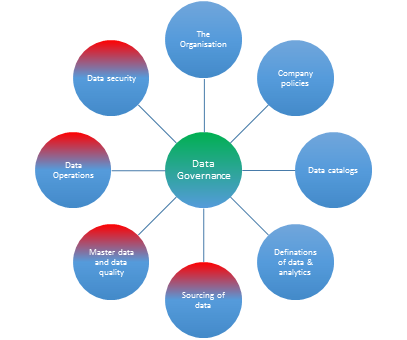
Data Governance gaps will lead to attacks and ransom. Can you afford this risk?
Author: John Williams
The corporate cockpit deals with collaborative data management and several gaps need to be addressed to mitigate risks and exposure. The dashboard below highlights risks, assessments and maturity of compliances, in case you are the pilot.
Key takeaway
Strategic operationalization offers areas of blocks for data governance and GDPR compliances.
Invest in a long-term effort
Organizations have woken up to high risks and GDPR compliances related to data governance. Having a mental wall against any initiative that pertains to it can be detrimental to any data-driven systems which are in force for operations. New executives need to take this position seriously and immediately invest in operational strategies with a long-term vision.
We have for you a large platform to drive alignment and new capabilities with it. As it may be the case, this investment can be explained and divided into eight parts. Keeping internal teams assigned to focus on these parts will help to address gaps, to act with maturity and deal with them.

Eight parts that make the organization data-driven
Keep this diagram on the dashboard to understand how data governance is strategized. The blue grades show the data assets an organization is responsible for. The management needs to understand the various data assets required for planning operations.
The red-blue grades focus on driving business data through hybrid applications, the technical protocol of managing the sources. They are used for KPIs, internal applications, analytics and deriving opportunities to get more business.
The diagram further helps leaders to prioritize operations and if address any gaps that block progress. Making such a dashboard is crucial when a new product is being designed. It will have to fall in line with security, policies, and market standards, and consider other data definitions or GDPR compliances to be followed.
Solutions to address gaps
To ensure that there are the fewest gaps to be addressed, the following practices are essential:
- Register for mandatory compliances like GDPR, and establish it early on as a long-term investment.
- The lifecycle preparation should be complete. This is one area where gaps can create confusion or miscommunications.
- Place a team for data identification and classification.
- Data resource should be in context to the operations.
- All personal data should have strict company policy of governance.
- Risk measures need to be identified during the planning stage along with the mitigating processes.
- A large organization needs DPI and LIA assessments.
- When gaps are addressed, improvements are inevitable.
- Change management needs to be addressed.
- Keep the trigger on workflows and make role-based dashboards to communicate effectively.
Data governance involves many teams, processes, and technologies. The people involved need to have an explicit understanding as to how they contribute the maximum to its success.
However, if the people in the cockpit fail to appreciate the value of organizational strategies, disaster may strike in the form of data breach, attacks, or ransom. Are you ready to risk the entire business? Or would you rather comply with governance standards?




